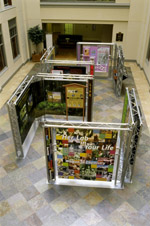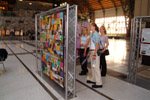|
|
Vol.
26 No. 6
November-December 2004
Women in Chemistry: Her Lab in Your Life*
Her Lab in Your Life: Women in Chemistry is a new exhibition that takes a fresh look at everyday life, revealing how chemical science and engineering help shape it. Designed by the Chemical Heritage Foundation (CHF)—a U.S.-based foundation—this exhibition showcases women chemists who have helped create our modern world and their historic contributions to science and technology. From the action of atoms to the substance of stars, these women have given us new visions of the material world and our place in it. The exhibition—traveling or online—was created especially for high school and college students but designed to engage general audiences. by Josh McIlvain
CHF’s newest traveling exhibit, Her Lab in Your Life: Women in Chemistry, focuses on the rich history of women chemists by highlighting some of their accomplishments from the Renaissance to the present. The exhibit’s purpose is to interest teenage women in the history of women chemists so that they will view a career in chemistry as a possibility.
We must show to the girls who are studying science in our schools that it has a very close relation to our everyday life.—Ellen H. Richards (1879)
|
Why was this audience chosen? The words of Stephanie Burns (president and chief operating officer of Dow Corning) in Chemical and Engineering News answer that question: “We know that young girls are interested in science during their early years in school, but by the time they get into high school, they lose interest. We have to put more emphasis into making science fun at the high-school level.” Thanks to the generous support of the Hach Scientific Foundation, Her Lab in Your Life was created to meet this challenge.
The central message of Her Lab in Your Life is that women’s important contributions to chemistry have helped create the world we live in today. To promote this message, the exhibit team concentrated on three related themes: women chemists have improved our understanding of the physical world, they have helped shape the material circumstances and popular culture of our everyday lives, and they have broken new ground in the chemical professions and served as role models for young women.
Choosing the Women and Their Story
Faced with the difficult task of choosing which important and interesting women chemists to include, the exhibit team eventually selected 68 and created research files for each one. Such a large number is clear proof that the achievements of women chemists are not isolated blips on a professional map. Many who did not make it into the panel of the traveling exhibit have been included on the exhibit’s companion Web site.
 |
Some of the women highlighted in Her Lab in Your Life are still alive and active chemists. Also included are some famous women in the history of chemistry, such as Marie Curie, Dorothy Crowfoot Hodgkin, and Ellen Richards; their inclusion helps “ground” the rest of the experience, for theirs are among the few names visitors will likely recognize. The exhibit discusses many professions, representing the prominence of women chemists in several chemical fields and showing visitors the variety of careers to which chemistry can lead. Her Lab in Your Life also points out that women chemists from many backgrounds have made important contributions to chemistry.
Creating an exhibit on the history of women chemists that would engage a teenage audience presented an exciting challenge. The exhibit would also need to travel, be durable, and yet have enough presence to intrigue visitors to stop and spend time with it. How would the exhibit present the stories of Shannon Lucid, the NASA biochemist who set the American record (since broken) for most days in space; Susan Solomon, who helped determine the chemistry behind the ozone hole; Allene Rosalind Jeanes, who helped develop intravenous fluids and invent xanthan gum; and over 60 other chemists to a technologically sophisticated, media-savvy, and notoriously fickle audience used to high-speed Internet connections, iPods, factoids, and MTV?
In an interview I conducted with Melissa Sherman, global new business manager at DuPont, she explained how a college internship at 3M was her first exposure to “real world” applications of chemistry: “I became aware that chemistry was involved in the plastic on your computer keyboard, the fibers in your carpet, the fibers in your clothing, the cosmetics you wear on your face, the perfumes you use, the hair care products you use, as well as the plastic on automobiles or the rubber on your tires.” The ubiquity of chemistry and how it has shaped and continues to shape our everyday lives is what makes its history so interesting. The exhibit team uses this ubiquity as the setting for the stories of women chemists. Shaping and Designing the Exhibit
First came the physical form of the exhibit. Displays would be captured on all four sides of freestanding, L-shaped structures, six-and-a-half-feet tall. These Ls, of which there are four, can be configured in a variety of ways to fit a variety of rooms. Since visitors could approach the exhibit from any direction, the design had to avoid making viewers follow a mandatory path to grasp the exhibit’s ideas. Twelve different thematic stations were created to frame the stories of the women chemists: Life (biochemistry), Medicine (pharmaceuticals), Stuff (materials), Environment, Discovery, Style (Cosmetics and fashion), Food, Sanitation, Work (variety of careers), Knowledge (education), Challenges, and Chips (semiconductors).
 |
The exhibit’s design took cues from today’s youth culture—the genres teenage women favor and the places they find familiar. Borrowing from graphic novels, the Medicine station uses comic-book art to tell the stories of Gertrude Elion creating drugs for leukemia, herpes, and meningitis; Dorothy Hodgkin determining penicillin structure; and Chen Zhao helping develop protease inhibitors to fight AIDS. The Style station features a mock cover of a fashion magazine showing a model wearing fashion accessories and clothing that are then deconstructed to relate them to various women chemists who created them—such as Hazel Bishop and her no-smear lipstick, and Edith M. Flanigen and the synthetic emeralds she made (originally for masers). The Sanitation station is set in a restroom (the sinks side) and features Ellen Swallow Richards’ survey of Massachusetts’s water quality in the 1870s—work that led to the water-quality standards we take for granted today.
In the Challenges station, set in a dorm room, Her Lab in Your Life addresses the barriers that women faced in education and the chemical professions, particularly throughout the 20th century. These challenges—from outright discrimination to subtler forms of cultural discouragement—and the strides made in breaking them down are placed in the context of the broader story of the women’s rights movement. That context is relevant because despite all the prior accomplishments of women chemists, they did not have a legal basis for fighting discrimination until the Civil Rights Act of 1964 was passed. The most telling artifacts of cultural sexism are two chemistry sets from the early 1960s. “Chemistry Set for Boys,” encased in metal, proudly displays on the front two boys playing with chemistry; the “Lab Technicians Set for Girls,” which lacks a picture but comes in a pink zippered briefcase with light blue trim, risks being mistaken for a make-up kit. Balancing this history of oppression and discrimination are the stories of “firsts” for women chemists, which include Gerty Cori, the first American woman to win a Nobel Prize in the sciences (1947); Marie Daly, the first African-American woman to earn a Ph.D. in chemistry (1947); and Anna Harrison, the first woman elected president of the American Chemical Society (1978).
The most telling artifacts of cultural sexism are two chemistry sets from the early 1960s.
|
The Knowledge station reveals the power of education and the danger of being kept out of the classroom. Is chemistry class a pain? Her Lab in Your Life asks, well, what if you weren’t allowed to go? In the 19th century most young women would have needed Jane Marcet’s Conversations on Chemistry to learn the subject. Most universities and colleges simply did not let women into chemistry classes. It took a dedicated effort from women’s colleges like Mount Holyoke, Vassar, and Bryn Mawr to ensure that young women could not only learn chemistry but also be good investigative chemists. Nowadays your chemistry teacher may be a woman (Linda Ford was the ACS High School Chemistry Teacher of the Year in 2003) and your textbook may be written by a woman. The series of popular textbooks that Mary Fieser wrote with her husband Louis were innovative in their use of real applications for chemistry in medicine and industry. Prominent in the exhibit is a large photograph of a modern high-school chemistry class; viewed from one angle, the girls disappear from the photograph, serving as a reminder for visitors not to take their access to education for granted.
|
| The Chemical Heritage Foundation is an Associated Organization of IUPAC. It serves the community of the chemical and molecular sciences, and the wider public, by treasuring the past, educating the present, and inspiring the future. |
It is important, however, not to tell the story of women chemists simply as a story of struggle and perseverance. Emphasizing the story of struggle may conceal the story of scientific accomplishment. Further, the exhibit should not give its target audience the over-arching impression that if a young woman goes into chemistry, the rest of her life will be one big migraine. The aim instead is to show her how chemistry leads to diverse professions that make significant impacts on people’s lives.
In an interview with CHF, Margaret Tolbert, a senior spokesperson for the National Science Foundation and former director of the New Brunswick Laboratory, a government research facility for nuclear chemistry, made this point: “Young women ... should make efforts to find out the diversity of careers that one can have as a result of having a degree in chemistry.” When asked about her own experience in the world of chemistry, Tolbert responded, “My experience as a woman in chemistry and management has been most positive. Although I have encountered some challenges, there were none that I could not overcome.”
Whether learning about the chemistry of food and how Cecile Hoover Edwards devised protein-rich vegetarian diets based on her chemical investigations and well-balanced, nutritious, and affordable diets for low-income families, or about how Rosalind Franklin’s X-ray crystallography determined the double helix structure of DNA, visitors can wake up to the chemistry all around them—and take that interest into the future.
*This article first appeared in Chemical Heritage, spring 2004 issue; reproduced with permission from the CHF. Josh McIlvain <[email protected]> is staff researcher/fellowship coordinator for the Beckman Center for the History of Chemistry at the Chemical Heritage Foundation, in Philadelphia, Pennsylvania, USA. To learn about hosting the exhibit, contact Josh by e-mail or by phone at 215 925 2178, ext 238.
www.chemheritage.org
Page
last modified 10 November 2004.
Copyright © 2003-2004 International Union of Pure and
Applied Chemistry.
Questions regarding the website, please contact [email protected]
|